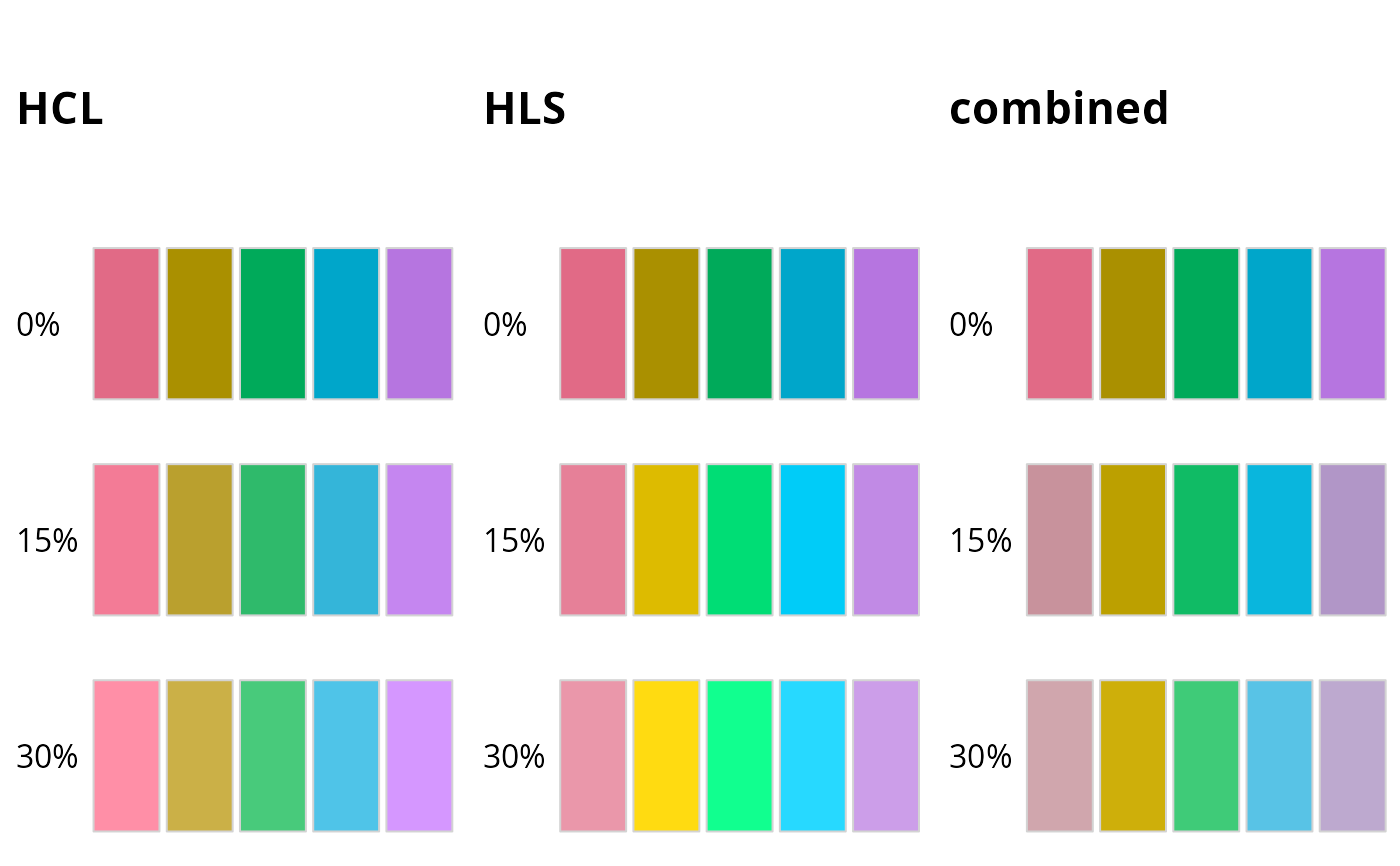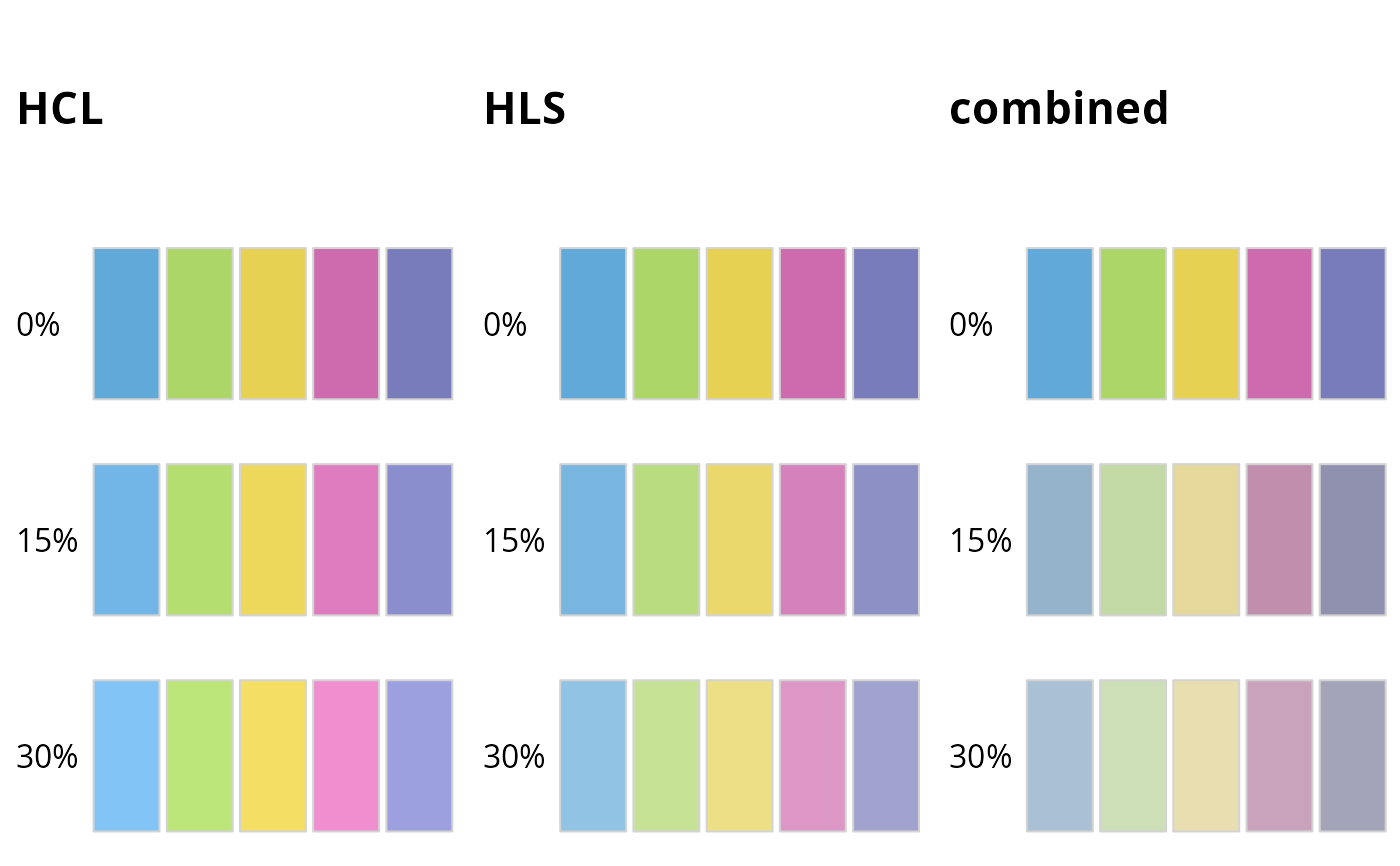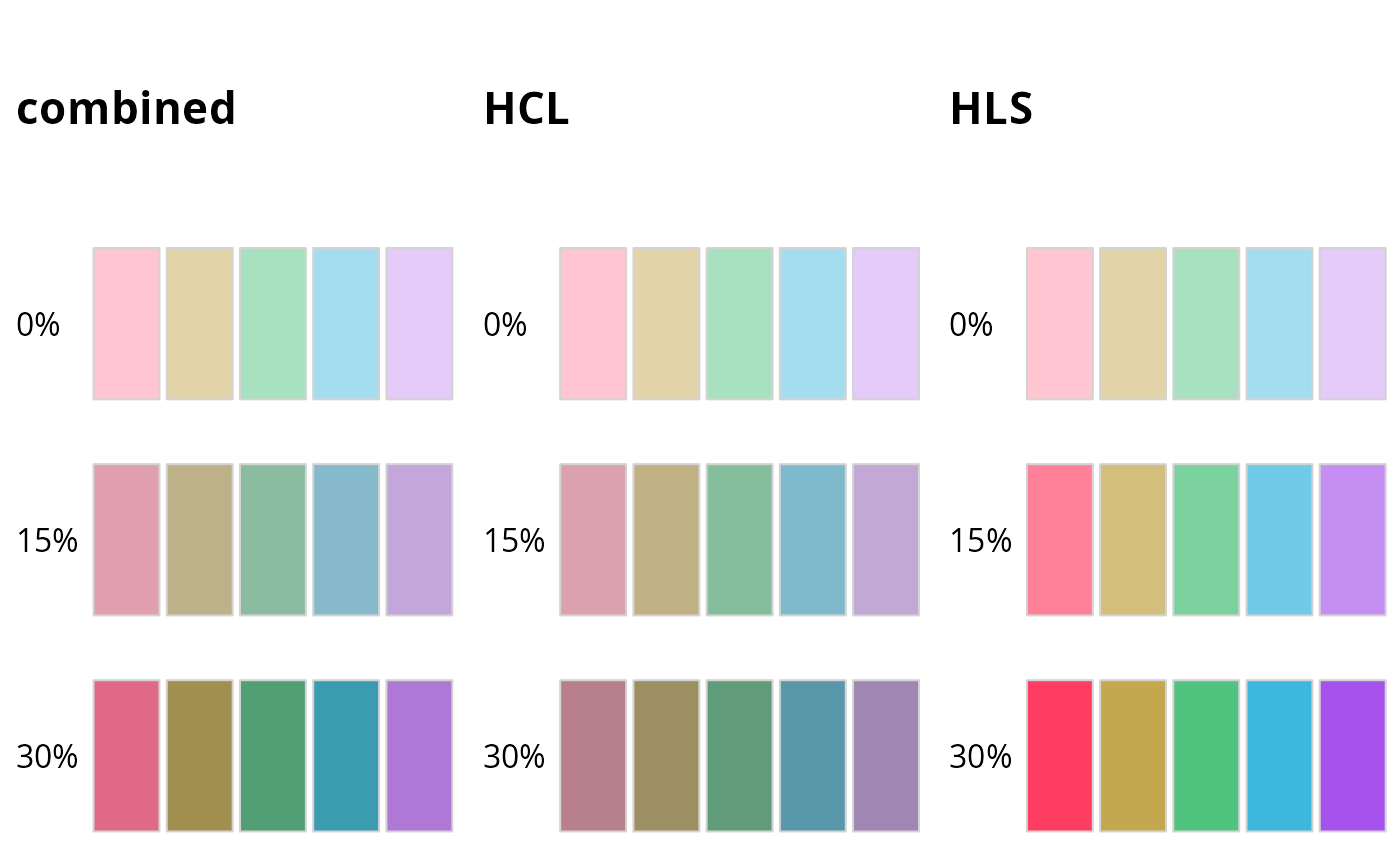Algorithmically Lighten or Darken Colors
lighten.RdThe functions lighten and darken take a vector of R colors and adjust the colors such that
they appear lightened or darkened, respectively.
Arguments
- col
vector of any of the three kind of R colors, i.e., either a color name (an element of
colors), a hexadecimal string of the form"#rrggbb"or"#rrggbbaa"(seergb), or an integerimeaningpalette()[i].- amount
numeric specifying the amount of lightening. This is applied either multiplicatively or additively to the luminance value, depending on the setting of
method(either relative or absolute). Negative numbers cause darkening.- method
character string specifying the adjustment method. Can be either
"relative"or"absolute".- space
character string specifying the color space in which adjustment happens. Can be either
"HLS"or"HCL".- fixup
logical If set to
TRUE, colors that fall outside of the RGB color gamut are slightly modified by translating individual primary values so they lie between 0 and 255. If set toFALSE, out-of-gamut colors are replaced byNA.- ...
Other parameters handed to the function
lighten().
Value
A character vector with (s)RGB codings of the colors in the palette.
Details
The color adjustment can be calculated in three different color spaces.
If
space = "HCL", the colors are transformed to HCL, (polarLUV), the luminance component L is adjusted, and then the colors are transformed back to a hexadecimal RGB string.If
space = "HLS", the colors are transformed to HLS, the lightness component L is adjusted, and then the color is transformed back to a hexadecimal RGB string.If
space = "combined", the colors are first adjusted in both the HCL and HLS spaces. Then, the adjusted HLS colors are converted into HCL, and then the chroma components of the adjusted HLS colors are copied to the adjusted HCL colors. Thus, in effect, the combined model adjusts luminance in HCL space but chroma in HLS space.
We have found that typically space = "HCL" performs best for lightening colors and space = "combined"
performs best for darkening colors, and these are the default settings for lighten and darken,
respectively.
Regardless of the chosen color space, the adjustment of the L component can occur by two methods, relative
(the default) and absolute. Under the absolute method, the adjustment is L +/- 100 * amount when
lightening/darkening colors. Under the relative method, the adjustment is 100 - (100 - L) * (1 - amount) when
lightening colors and L * (1 - amount) when darkening colors.
Programmatically lightening and darkening colors can yield unexpected results (see examples). In HCL space,
colors can become either too gray or overly colorful. By contrast, in HLS space it can happen that the
overall amount of lightening or darkening appears to be non-uniform among a group of colors that are
lightened or darkened jointly, and again, colors can become either too gray or overly colorful. We
recommend to try different color spaces if the default space for the chosen function (lighten
or darken) does not look right in a specific application.
References
Zeileis A, Fisher JC, Hornik K, Ihaka R, McWhite CD, Murrell P, Stauffer R, Wilke CO (2020). “colorspace: A Toolbox for Manipulating and Assessing Colors and Palettes.” Journal of Statistical Software, 96(1), 1--49. doi:10.18637/jss.v096.i01
See also
Examples
# lighten dark colors, example 1
cl <- qualitative_hcl(5)
swatchplot(list(
HCL = rbind("0%" = cl,
"15%" = lighten(cl, 0.15),
"30%" = lighten(cl, 0.3)),
HLS = rbind("0%" = cl,
"15%" = lighten(cl, 0.15, space = "HLS"),
"30%" = lighten(cl, 0.3, space = "HLS")),
combined = rbind("0%" = cl,
"15%" = lighten(cl, 0.15, space = "combined"),
"30%" = lighten(cl, 0.3, space = "combined"))),
nrow = 4, line = 2.5
)
 # lighten dark colors, example 2
cl <- c("#61A9D9", "#ADD668", "#E6D152", "#CE6BAF", "#797CBA")
swatchplot(list(
HCL = rbind("0%" = cl,
"15%" = lighten(cl, 0.15),
"30%" = lighten(cl, 0.3)),
HLS = rbind("0%" = cl,
"15%" = lighten(cl, 0.15, space = "HLS"),
"30%" = lighten(cl, 0.3, space = "HLS")),
combined = rbind("0%" = cl,
"15%" = lighten(cl, 0.15, space = "combined"),
"30%" = lighten(cl, 0.3, space = "combined"))),
nrow = 4, line = 2.5
)
# lighten dark colors, example 2
cl <- c("#61A9D9", "#ADD668", "#E6D152", "#CE6BAF", "#797CBA")
swatchplot(list(
HCL = rbind("0%" = cl,
"15%" = lighten(cl, 0.15),
"30%" = lighten(cl, 0.3)),
HLS = rbind("0%" = cl,
"15%" = lighten(cl, 0.15, space = "HLS"),
"30%" = lighten(cl, 0.3, space = "HLS")),
combined = rbind("0%" = cl,
"15%" = lighten(cl, 0.15, space = "combined"),
"30%" = lighten(cl, 0.3, space = "combined"))),
nrow = 4, line = 2.5
)
 # darken light colors, example 1
cl <- qualitative_hcl(5, "Pastel 1")
swatchplot(list(
combined = rbind("0%" = cl,
"15%" = darken(cl, 0.15),
"30%" = darken(cl, 0.3)),
HCL = rbind("0%" = cl,
"15%" = darken(cl, 0.15, space = "HCL"),
"30%" = darken(cl, 0.3, space = "HCL")),
HLS = rbind("0%" = cl,
"15%" = darken(cl, 0.15, space = "HLS"),
"30%" = darken(cl, 0.3, space = "HLS"))),
nrow = 4, line = 2.5
)
# darken light colors, example 1
cl <- qualitative_hcl(5, "Pastel 1")
swatchplot(list(
combined = rbind("0%" = cl,
"15%" = darken(cl, 0.15),
"30%" = darken(cl, 0.3)),
HCL = rbind("0%" = cl,
"15%" = darken(cl, 0.15, space = "HCL"),
"30%" = darken(cl, 0.3, space = "HCL")),
HLS = rbind("0%" = cl,
"15%" = darken(cl, 0.15, space = "HLS"),
"30%" = darken(cl, 0.3, space = "HLS"))),
nrow = 4, line = 2.5
)
 # darken light colors, example 2
cl <- c("#CDE4F3","#E7F3D3","#F7F0C7","#EFCFE5","#D0D1E7")
swatchplot(list(
combined = rbind("0%" = cl,
"15%" = darken(cl, 0.15),
"30%" = darken(cl, 0.3)),
HCL = rbind("0%" = cl,
"15%" = darken(cl, 0.15, space = "HCL"),
"30%" = darken(cl, 0.3, space = "HCL")),
HLS = rbind("0%" = cl,
"15%" = darken(cl, 0.15, space = "HLS"),
"30%" = darken(cl, 0.3, space = "HLS"))),
nrow = 4, line = 2.5
)
# darken light colors, example 2
cl <- c("#CDE4F3","#E7F3D3","#F7F0C7","#EFCFE5","#D0D1E7")
swatchplot(list(
combined = rbind("0%" = cl,
"15%" = darken(cl, 0.15),
"30%" = darken(cl, 0.3)),
HCL = rbind("0%" = cl,
"15%" = darken(cl, 0.15, space = "HCL"),
"30%" = darken(cl, 0.3, space = "HCL")),
HLS = rbind("0%" = cl,
"15%" = darken(cl, 0.15, space = "HLS"),
"30%" = darken(cl, 0.3, space = "HLS"))),
nrow = 4, line = 2.5
)
